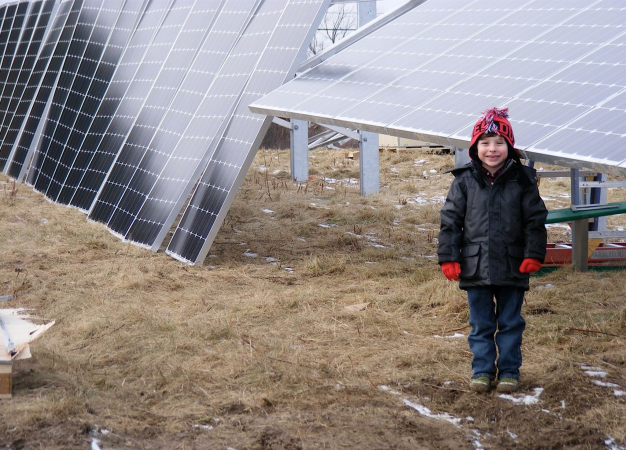Editor’s note: This commentary is by Emily McManamy, who is the storyteller at SunCommon. She is a native Vermonter who lives in Starksboro.
When my husband and I were house hunting in 2010, Starksboro was not on our radar. We were young 20-somethings on the hunt for an affordable property in Chittenden County unaware of Addison County’s rural charm. As native Vermonters, we craved space, peace and quiet and hunted for the progressive, inventive ethic we enjoyed from our college years in Boston. And that’s how we found Starksboro.
While we were house hunting, Starksboro was busy planning its own future. The town decided to power its municipal buildings and Robinson Elementary School with clean, renewable and affordable energy. The town went solar in October 2010 by installing a 100kW project behind Robinson Elementary School with the help of AllEarth Renewables.
I was drawn to Starksboro’s commitment to our green energy future and now, nearly five years later, I’m proud that my fellow Starksboro residents voted to purchase the array providing healthy, safe and affordable energy for our future.
Community-scale solar has been hot in the headlines this year as we see increased presence in our towns. I took exception to an April 5 editorial by Mr. Peter Rothschild (“A deep divide”) about the recent solar siting hearing at the Statehouse. I was in attendance that evening and spoke in support of solar. And while some of the speakers were fellow young professionals, I was surprised to see Mr. Rothschild frame his piece as solar being a simple division of the ages: “Many of the people advocating for absolutely no regulation of the siting of solar projects were under the age of 30, an age below which most folks may find it hard to amass enough money to buy a home. For most people who own a home, it is their largest single investment, so it’s natural to expect them to fight for some regulations to protect the value of their homes.”
I agree. When I was a 26-year-old young professional, I found it difficult to afford a home in Vermont. The high cost of living, expensive oil bills and tight job market encouraged my husband and me to consider leaving our native Green Mountains in search of not-so-greener pastures elsewhere. When the economy tanked and my job security was in question, I again turned to solar’s promising future by joining the ever-growing clean energy workforce, now 15,000 strong statewide. I, too, am looking to “protect the value” of my home, but I choose to do so by investing in an infrastructure that supports Vermont’s clean energy independence. I choose solar.
I urge Mr. Rothschild not to discount the voice of fellow Vermont residents because of their age. I dispute his argument that this is simply a demographic debate. But, to his point, if indeed those supporting solar tend to be young renters, then I imagine this is the very generation that the Vermont housing market will depend on as these renters search for affordable, clean, renewable energy options in their neighborhood. This generation is, after all, Vermont’s future tax base. I don’t think young Vermonters are taking a “free-rider position” in the debate. I see them working toward securing their own existence in a future they have a hand in designing.
This is where I want to raise my family. I want to live in a place that not only has accepted responsibility for our impact on the climate, but is also actively working toward a solution. My kids will learn in a classroom powered by solar, with the very power source beautifully planted in the field by the school. No longer will generations be disconnected from their energy sources. As the former Robinson Elementary School Principal Dan Noel once said, “It’s the right thing to do, because we’re not relying on other people to make our electricity. That’s a very Vermont sort of independence.” The lessons of climate change will not be taught in our students’ textbooks, but every single day when they walk into their solar-powered classroom.
Let’s set an example by supporting solar instead of discounting the very voices that depend on it the most.
